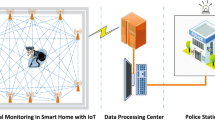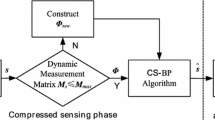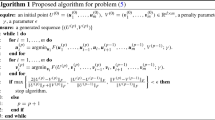Abstract
Considering practical device-free localization (DFL), the localization precision is usually proportional to the sensor density, with an ordinary arrangement. A better localization performance generally indicates a higher density of the sensor nodes that need to be deployed. To overcome this problem, we propose a new framework for dispatching sensor nodes. Regarding this framework, only few sensor nodes are applied to achieve an excellent localization performance. We consider the DFL problem as a sparse coding problem. To maintain the convexity of the cost function for more accurate solutions, we introduce the generalized minimax-concave (GMC) regularization to approximate the \(\ell _0\)-norm regularization. The global optimal solution can be identified by adopting the forward-backward splitting algorithm (FBS). Furthermore, the localization error is further decreased by the proposed adaptive relaxation localization (ARL) criteria for target localization. We tackled two experimental scenes in a real laboratory and compared the performance of the proposed algorithm with that of other algorithms using different regularizations. The experimental results show 100\(\%\) grid localization accuracy under the \(0.5 \times 0.5\) m grid scene. After adopting the ARL criteria, the average localization error decreased from 0.098 to 0.053 m in the \(0.25\times 0.25\) m grid scene, with an increased rate of 45.9\(\%\). This is the best performance compared to state-of-the-art framework.









Similar content being viewed by others
References
Shit RC, Sharma S, Puthal D, James P, Ranjan R (2019) Ubiquitous localization (ubiloc): a survey and taxonomy on device free localization for smart world. IEEE Commun Surveys Tutor 21(99):3532–3564
Moustafa Y, Matthew M, Ashok A (2007) Challenges: device-free passive localization for wireless environments. In: Proceedings of the 13th annual ACM international conference on mobile computing and networking, pp 222–229
Liu B, Zhou W, Zhu T, Gao L, Luan TH, Zhou H (2016) Silence is golden: enhancing privacy of location-based services by content broadcasting and active caching in wireless vehicular networks. IEEE Trans Veh Technol 65(12):9942–9953
Chiang T-H, Chuang Y-T, Ke C-L, Chen L-J, Tseng Y-C (2017) Calorie map: an activity intensity monitoring system based on wireless signals. In: 2017 IEEE wireless communications and networking conference (WCNC), IEEE, pp 1–6
Li D, Lu Y, Xu J, Ma Q, Liu Z (2019) ipac: integrate pedestrian dead reckoning and computer vision for indoor localization and tracking. IEEE Access 7(99):183514–183523
Jiang X (2021) Human tracking of track and field athletes based on fpga and computer vision. Microprocess Microsyst 83(4):104020
Lu H, Zhang M, Xu X, Li Y, Shen HT (2021) Deep fuzzy hashing network for efficient image retrieval. IEEE Trans Fuzzy Syst 29(1):166–176
Sun J, Li Y (2021) Multi-feature fusion network for road scene semantic segmentation. Comput Electr Eng 92:107155
Lu H, Yang R, Deng Z, Zhang Y, Gao G, Lan R (2021) Chinese image captioning via fuzzy attention-based densenet-bilstm. ACM Trans Multimedia Comput Commun Appl (TOMM) 17(14):1–18
Pahlavan K, Krishnamurthy P, Geng Y (2015) Localization challenges for the emergence of the smart world. IEEE Access 3:3058–3067
Yang M, Wu H, Liu Z, Ding S, Peng H (2019) Indoor positioning using public fm and dtmb signals based on compressive sensing. China Commun 16(5):171–180
Jun WANG, Zhaotao QIN, Fei GAO, Shaoming WEI (2019) An approximate maximum likelihood algorithm for target localization in multistatic passive radar. Chin J Electron 28(1):195–201
Ferrand S, Alouges F, Aussal M (2020) A real-time indoor localization method with low-cost microwave doppler radar sensors and particle filter. Computers helping people with special needs. In: 17th international conference, ICCHP (2020), Lecco, Italy, September 9–11, 2020, Proceedings. Part I
Medina C, Segura JC, Torre A (2013) Ultrasound indoor positioning system based on a low-power wireless sensor network providing sub-centimeter accuracy. Sensors 13(3):3501–3526
Alzubi JA, Bharathikannan B, Tanwar S, Manikandan R, Khanna A, Thaventhiran C (2019) Boosted neural network ensemble classification for lung cancer disease diagnosis. Appl Soft Comput 80:579–591
Sadeghi M, Behnia F, Amiri R, Farina A (2021) Target localization geometry gain in distributed mimo radar. IEEE Trans Signal Process 69:1642–1652
Jie W, Xiao Z, Gao Q, Hao Y, Wang H (2017) Device-free wireless localization and activity recognition: a deep learning approach. IEEE Trans Veh Technol 66(7):6258–6267
Haute TV, Verbeke B, Poorter ED, Moerman I (2017) Optimizing time-of-arrival localization solutions for challenging industrial environments. IEEE Trans Ind Inf 13(3):1430–1439
Alzubi OA, Alzubi JA, Alweshah M, Qiqieh I, Ramachandran M (2020) An optimal pruning algorithm of classifier ensembles: dynamic programming approach. Neural Comput Appl 32(5):1–17
May M, Moustafa Y (2009) Smart devices for smart environments: device-free passive detection in real environments. In: 2009 IEEE international conference on pervasive computing and communications. IEEE, pp 1–6
Sabek I, Youssef M, Vasilakos AV (2012) Ace: an accurate and efficient multi-entity device-free wlan localization system. IEEE Trans Mobile Comput 14(2):261–273
Wilson J, Patwari N (2010) Radio tomographic imaging with wireless networks. IEEE Trans Mob Comput 9(5):621–632
Wang J, Gao Q, Wang H, Yu Y, Jin M (2013) Time-of-flight-based radio tomography for device free localization. IEEE Trans Wireless Commun 12(5):2355–2365
Wang J, Gao Q, Wang H, Cheng P, Xin K (2015) Device-free localization with multidimensional wireless link information. IEEE Trans Veh Technol 64(1):356–366
Wang J, Fang D, Chen X, Yang Z, Xing T, Cai L (2013) Lcs: compressive sensing based device-free localization for multiple targets in sensor networks. In: 2013 proceedings IEEE INFOCOM, pp 145–149. IEEE
Ju W, Fang D, Zhe Y, Jiang H, Chen X, Xing T, Lin C (2017) E-hipa: an energy-efficient framework for high-precision multi-target-adaptive device-free localization. IEEE Trans Mob Comput 16(3):716–729
Xiao J, Wu K, Yi Y, Wang L, Ni LM (2013) Pilot: passive device-free indoor localization using channel state information. In: 2013 IEEE 33rd international conference on distributed computing systems, pp 236–245. IEEE
Konings D, Alam F, Noble F, Lai MK (2019) Springloc: a device-free localization technique for indoor positioning and tracking using adaptive rssi spring relaxation. IEEE Access 7(99):56960–56973
Donoho DL (2006) Compressed sensing. IEEE Trans Inf Theory 52(4):1289–1306
Baraniuk RG (2007) Compressive sensing [lecture notes]. IEEE Signal Process Mag 24(4):118–121
Zhao L, Huang H, Li X, Ding S, Zhao H, Han Z (2019) An accurate and robust approach of device-free localization with convolutional autoencoder. IEEE Internet Things J 6(3):5825–5840
Huang H, Zhao H, Li X, Ding S, Zhao L, Li Z (2018) An accurate and efficient device-free localization approach based on sparse coding in subspace. IEEE Access 6:61782–61799
Han Z, Su C, Ding S, Huang H, Zhao L (2019) Device-free localization via sparse coding with log-regularizer. In: 2019 IEEE 10th international conference on awareness science and technology (iCAST), pp 1–6. IEEE
Xiang L, Ding S, Li Z, Tan B (2017) Device-free localization via dictionary learning with difference of convex programming. IEEE Sens J 17(17):5599–5608
Guo Y, Huang K, Jiang N, Guo X, Li Y, Wang G (2015) An exponential-rayleigh model for rss-based device-free localization and tracking. IEEE Trans Mob Comput 14(3):484–494
Selesnick I (2017) Sparse regularization via convex analysis. IEEE Trans Signal Process 65(17):4481–4494
Tan B, Li Y, Zhao H, Li X, Ding S (2020) A novel dictionary learning method for sparse representation with nonconvex regularizations. Neurocomputing 417:128–141
Avellaneda M, Davis G, Mallat S (1997) Adaptive greedy approximations. Constr Approx 13(1):57–98
Zou J, Shen M, Zhang Y, Li H, Liu G, Ding S (2019) Total variation denoising with non-convex regularizers. IEEE Access 7:4422–4431
Wright J, Yang YA, Ganesh A, Sastry SS, Ma Y (2009) Robust face recognition via sparse representation. IEEE Trans Pattern Anal Mach Intell 44(12):2368–2378
Gheisari M, Panwar D, Tomar P, Harsh H, Alzubi JA (2019) A optimization model for software quality prediction with-case study analysis using matlab. IEEE Access 7(99):1
Beck A, Teboulle M (2009) A fast iterative shrinkage-thresholding algorithms for linear inverse problems. SIAM J Imag Sci 2(1):1936–4954
Liu T, Luo X, Liang Z (2018) Enhanced sparse representation-based device-free localization with radio tomography networks. J Sensor Actuat Netw 7(1):7
Li Z, Ding S, Hayashi T, Li Y (2017) Incoherent dictionary learning with log-regularizer based on proximal operators. Digital Signal Process 63:86–99
Acknowledgements
This study was supported in part by the Guangxi Postdoctoral Special Foundation and the National Natural Science Foundation of China under Grant 61903090 and 62076077, the Dean Project of Guangxi Wireless Broadband Communication and Signal Processing Key Laboratory.
Author information
Authors and Affiliations
Corresponding authors
Additional information
Publisher's Note
Springer Nature remains neutral with regard to jurisdictional claims in published maps and institutional affiliations.
Rights and permissions
About this article
Cite this article
Zhang, K., Tan, B., Ding, S. et al. Device-free indoor localization based on sparse coding with nonconvex regularization and adaptive relaxation localization criteria. Int. J. Mach. Learn. & Cyber. 14, 429–443 (2023). https://doi.org/10.1007/s13042-022-01559-x
Received:
Accepted:
Published:
Issue Date:
DOI: https://doi.org/10.1007/s13042-022-01559-x




